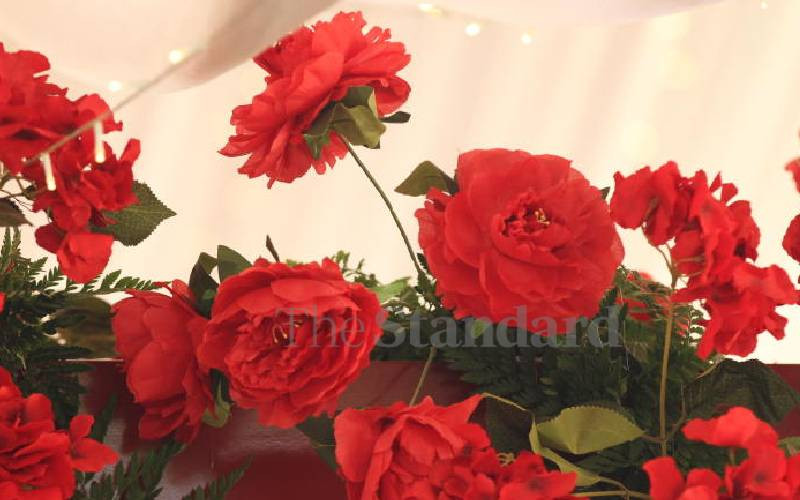
It might be a Midnight Sun, a Red Sensation, a Rubicon or even a Mirabel or any other shade of a red rose that you will find in the market as lovers exchange flowers to mark Valentine's Day.
While most people know roses generally by their colours, most do not know that roses have specific names too.
Further, rose flowers of different colours flood the markets at particular seasons of the year. And each signifies a different message.
"Valentine's Day is very important in the flower calendar. On this day, it is mostly the red roses that are most sought after. This is because the colour red symbolizes love and romance," Yvonne Tirop, Marketing and Business Development Manager at Sian Flowers said.
In February every year, shades of red like furiosa, mirabel, red sensation, madam red, and butterfly sensation, among other reds, flood the market.
But what is in a flower? Everything!
The colour and scent really matter, according to experts.
The emotion that comes with flowers through their scent might be one of many reasons why flowers are loved.
- Valentine's with a twist
- Post-Valentine's blues
- Life lessons from Sunday magazine's 2023 profiles
- The brighter side of simping
Keep Reading

Besides, flowers are used as the theme of the events, and colour also matters in sending a particular message.
While others smell soft, others fruity, peachy or even creamy, flowers have their calendars, according to the experts in the flower industry.
"The reds often top the calendar in February, the month of love. The yellows and their shades-like cream, come in during the Easter celebrations, and pink tops during Mothers' Day. The whites peak in June and July during the summertime in Europe when weddings are at the peak. People go for red and white during the Christmas season," said Tirop.
To prepare for Valentine's Day when demand for roses is high, firms start preparations in November.
"Often, once pruned, roses take up to two months to be harvested for export. Part of our preparations to handle large expert shipments to meet customer demands starts early in November. By February, the flowers are mature when they are picked and packaged. By February 7, the last batch of flowers specifically targeted for Valentine's were shipped," said Charles Mulemba, the general manager at the company.
He said by the time the flowers reach other countries, distributions begin from the wholesalers who distribute to retailers and finally reach the consumers on Valentine's Day.
"February is usually the busiest month of the year, and we are often prepared to handle huge demands. The good thing is that it often comes with a bonus when we meet and even exceed our targets," said Ruth Njeri, an employee at the flower farm.
For the local market, bulk buyers often place orders before the day or on D-day.

While the production of flowers is a continuous process, there are flowers targeted for particular seasons and production of the specific colour is often enhanced.
With flowers remaining one of the most loved plants, sustainability in the production of flowers has been key in some flower firms like Sian Roses.
Elizabeth Kimani, a quality assurance officer at the company, said that while Kenya leads the region in floriculture innovations, most production systems are carbon and resource-intensive.
"The current biggest debate is on global warming. With most investments being carbon and resource-intensive, there is a need for the adoption of renewable sources of energy that are sustainable to avoid over-reliance on non-renewable ones," she said.
She added; "Flower industry is one of the most vibrant sectors. Over the years, the industry has taken approaches to ensure sustainability in production. Among the major approaches we have taken is the adoption of solar, use of sea freight to ship flowers among other local approaches."
Raphael Kiptis, a finance officer at the company, said that while electricity bills could run up to Sh 10 million per month within the four flower farms, among them Sian.
He added that the unreliability of the power supply posed a major challenge to running huge investments that required sustainability.
"We shifted to renewable energy so that we could both reduce costs as well as lower our carbon footprints," he said.
 The Standard Group Plc is a multi-media organization with investments in media
platforms spanning newspaper print
operations, television, radio broadcasting, digital and online services. The
Standard Group is recognized as a
leading multi-media house in Kenya with a key influence in matters of national and
international interest.
The Standard Group Plc is a multi-media organization with investments in media
platforms spanning newspaper print
operations, television, radio broadcasting, digital and online services. The
Standard Group is recognized as a
leading multi-media house in Kenya with a key influence in matters of national and
international interest.









